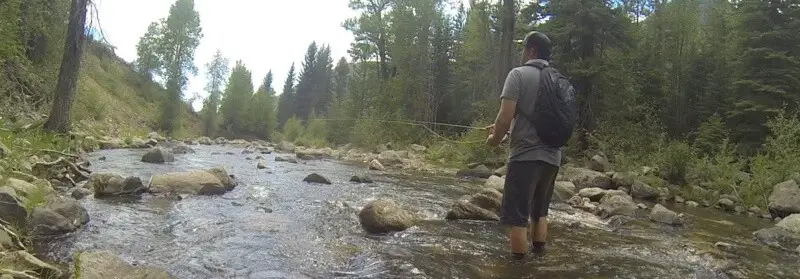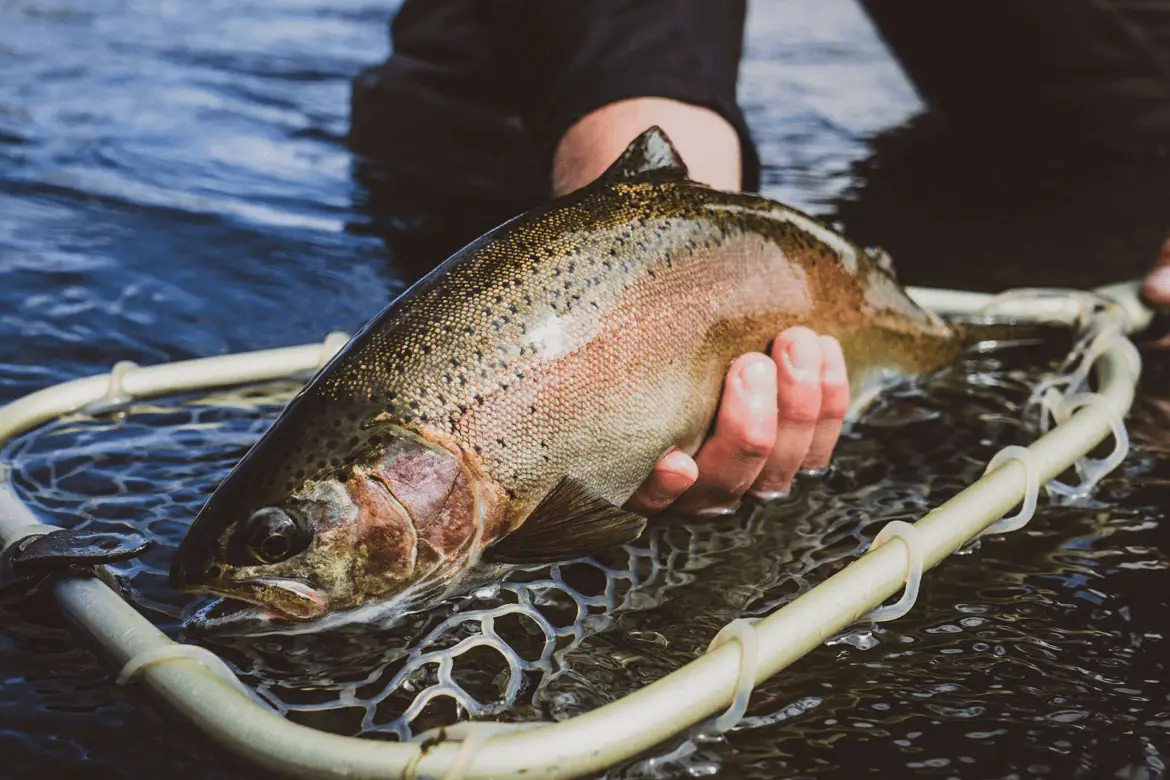Have you ever sat and admired anglers fly-fishing for trout, the stillness of the pre-dawn air, the slight rippling of the expertly thrown fly in the calm water. But is that the only way to catch trout? Do trout only catch surface prey? How deep do they move to feed in a water body?
Trout can be caught at depths ranging from between the surface and 65 feet in dams and lakes. The season and weather will play a role in determining at what depth trout are located in a water body. As a rule of thumb, the colder the water, the nearer to the surface trout can be caught.
Although trout have a range of depths they are found in, specific environmental factors can help us pinpoint, to a greater degree, just where these fish will be.
When Are Trout At What Depth?
The depth that trout are found in a body of water is determined by several variables.
Factors such as temperature, weather, season, time of day, food, cover and the type of water body are some examples.
The current season will play a tremendous role in determining what depth trout are found within a water body.
Below is a table comparing the various depths trout are commonly found at for each season of the year.
| Season | Depth |
| Summer | The summer season is the hottest time of the year. Trout will therefore move into deeper regions of the lake to access the colder water layers/strata. The range trout should be fished at during this time is between 50 and 65 feet deep. The idea is to try and target the band of water that is 53 degrees Fahrenheit in temperature. During the middle of summer, you will find the biggest challenge in catching trout |
| Fall | Similar temperatures occur between spring and fall. Trout can therefore be found between 35 and 45 feet during these seasons. The closer it is to summer, the deeper the trout will be. |
| Winter | Winter, being the coldest season, has both benefits and drawbacks for trout fishing. A benefit is that once the ice begins to form, the decrease in water temperature means that trout can be caught between the surface and 10 feet deep. A downside is that you will find that trout are quite sluggish and lethargic during the middle of winter. This means fishing for them is also made a bit more difficult, but not impossible! |
| Spring | Spring is also an “in-between” type of month. As the ice begins to melt, cold water moves in, so most of the early spring, you will be in the range of the surface to 20 feet deep, then between 35 and 45 feet deep in mid-spring, and finally between 50 and 65 feet deep in late spring as the temperature moves towards summer. |
Although not set in stone, these depths are a good guide for most big lakes.
If you are in a smaller lake fed by a spring or at the mouth of a river leading into a big lake, where there is a fair amount of water inflow, trout are often found at higher depths (closer to the surface).
This guide to depths is subject to various other weather conditions and temperatures. For example, if you are fishing for trout in the summer, but you go out before dawn, trout will be much higher up in the water body as the water temperature is still low enough to allow the trout to move freely.
Other factors like altitude, climate, recent rainfall, the type of water body and water movement will also play a role in determining at what depth trout can be found.
Colder areas (the northern reaches of the US) will generally provide better success for catching trout during the warmer months than a place with a warmer climate (southern US).
Larger, deeper lakes will generally remain colder, even during summer, so trout may be in higher numbers/easier to find. In contrast, smaller shallow lakes will be warmer and less favorable for trout and trout fishing. During warmer temperatures, trout will often move upriver to colder water.
An important note to make here is that an investment into a depth finder may be a more practical and efficient way to measure depth unless you’re a sucker for punishment and want to do a sounding every few meters!
As a final thought on this point, nothing beats a local knowledge of an area. Even if you’ve studied the charts and know all the theories about where trout should be found, sometimes it’s not the “right spot”.
Having local knowledge of where the trout usually bites adds that little bit extra of an advantage when it comes to depth, location, bait to use and technique.
Why Are Trout Found At Different Depths At Different Times Of The Year?
Trout need clean, cold, oxygenated water to thrive.
Any given body of water is divided into different strata or layers. These layers will be at different temperatures (because of how sunlight penetrates the water) and will have different dissolved oxygen levels.
Trout have an optimal temperature range of between 34 and 67 degrees Fahrenheit, especially when feeding. This means that whatever region of water (strata) is within that temperature range, this is where the trout will be found.
Another hugely important factor that contributes to the depth trout are found at is the amount of sunlight.
As mentioned, sunlight warms the water and creates bands or layers, with colder water below and warmer above. However, trout will also avoid higher levels of sunlight due to reduced upward (vertical) vision. This impairmentmakes trout more vulnerable to predation and, therefore, less likely to stick close to the surface.
If the day is overcast/cloudy, trout will be more inclined to be higher up in the strata as their vision is less impaired.
For the same reason, a lake with a lot of shade created by vegetation will also cause trout to be found higher up (or at least feed higher up) in these shady areas, even on warmer days/during spring and summer, within reason.
Trout Depth In Rivers Vs. Lakes

The type of water body will also play a tremendous role in delineating the depth of trout.
For the most part, a lake remains constant (especially big lakes) in terms of where the various temperature strata (layers of water) occur. This means that trout will be found at the depth you’d expect them on a specific day in the relevant season.
A smaller lake with a lot of water flowing in will cause these strata to “mix” and therefore cause trout to move around more in the water body. I.e., trout will be found higher up in a lake with colder water from a spring constantly flowing into it.
In rivers, trout are generally found in fast-flowing water catching prey by darting out from behind submerged boulders. The strata that we find in lakes are not as definitive in fast-flowing rivers due to the movement of water. This is especially true for smaller fast-flowing rivers.
During warmer temperatures, trout will generally still move into pools that are found within the river, moving back to faster-flowing areas to feed.
Larger rivers that are slower will resemble lakes a bit more in strata, and the depth guide will be more applicable. Trout will still generally feed closer to faster flowing water and then rest in slower flow areas.
Trout Fishing Resources
- 15 Reason’s Why You’re Not Catching Trout
- 20 Trout Fishing Tips to Catch More Fish
- What Pound Test to Use for Trout [Complete Guide]
- Best Time to Fish for Trout
- How to Catch Trout
Conclusion
The best plan is to get out there, no matter the season, armed with your trusty tackle box and start fishing. Trout are living, breathing creatures, and even though we know where to predict them being and when they can still surprise you!
With an understanding of where trout go and when coupled with local knowledge, there’s no reason not to go and catch some trout!

